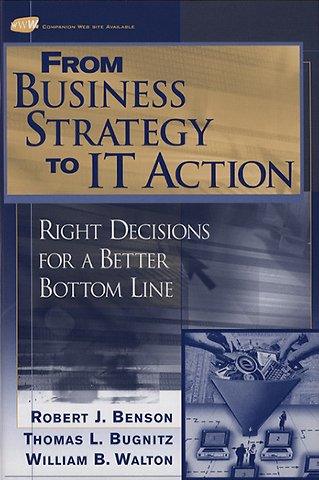From Business Strategy to IT Action
Right decisions for a better bottom line
Gebonden Engels 2004 1e druk 9780471491910Samenvatting
'From Business Strategy to IT Action' reikt allerlei soorten bedrijven van groot tot klein de tools aan om IT op een effectieve manier te integreren in de bedrijfsstrategie en effectieve en uitvoerbare strategieën voor 'bottom-line'-resultaten. De auteurs bieden CEO's, CFO's, CIO's en IT-managers een sterk en toegankelijk naslagwerk boordevol nuttig materiaal.
Specificaties
Lezersrecensies
Inhoudsopgave
Acknowledgments.
CHAPTER 1: Define the goals
Today's Reality.
The Entire IT Spend: Reducing Cost and Improving Bottom-Line Impact.
The Strategy-to-Bottom-Line Value Chain.
Disconnects.
Critical Success Factors.
Completing the Picture: The New Information Economics Practices.
Summary of the Book.
Define the Goals: Management Agenda.
CHAPTER 2: Ask the Right Questions.
The Right Questions Focus on Affordability and Impact.
Affordability Questions: The Starting Point for the Right Actions.
Impact Questions: The Roadmap for the Right Actions.
Examples: Answering the Questions.
The Contexts for Management Questions Are Planning and Budgeting Processes.
Why Ask Affordability and Impact Questions?
Taking Action.
Chapter Summary.
Ask the Right Questions: Management Agenda.
CHAPTER 3: Connect to the Bottom Line.
Bottom-Line Impact Based on Cause and Effect.
Cause and Effect Is Based on Management's Intentions.
Management's Strategic Intentions.
Principles of IT's Bottom-Line Impact.
Summary and Additional Implications.
Connect to the Bottom Line: Management Agenda.
CHAPTER 4: Understand Costs and Resources.
Introduction.
Origins of Portfolio Management.
IT Portfolio Management in Prioritization.
Portfolios in NIE Practices.
Four IT Portfolio Concepts.
Practical Problems in Applying Portfolio Management.
Summing Up Portfolios and Portfolio Management in Information Technology.
Chapter Summary.
Understand Costs and Resources: Management Agenda.
CHAPTER 5: Focus on the Right Things.
The Goals and Principles for Right Decisions/Right Results.
Goal 1: Actionable, Commonly Understood Strategic Intentions.
Goal 2: The Right Bottom-Line Results from IT.
Goal 3: The Right Management Culture and Management Roles.
Goal 4: Portfolios and Portfolio Management.
Goal 5: Actions and Results.
Summary of Right Decisions/Right Results—Goals and Principles.
Goals and Principles Applied to the Strategy-to-Bottom-Line Value Chain and NIE Practices.
Focus on the Right Things: Management Agenda.
CHAPTER 6: Adopt Effective Process to Produce Action.
The Strategy-to-Bottom-Line Value Chain.
Establishing the Process Connections.
Management Roles.
New Information Economics Practices.
Summing Up New Information Economics Practices.
Summing Up: Adopt Effective Process to Produce Action.
Adopt Effective Process to Produce Action: Management Agenda.
CHAPTER 7: Tackle the Practical Problems.
A Practical Perspective.
The Practical Problems Revolve around People.
Addressing Practical Problems: IT Impact Management.
Practical Problems Getting from Strategy to Bottom-Line Impact.
The Role of IT Impact Management.
Tackle the Practical Problems: Management Agenda.
CHAPTER 8: Make the Right Decisions.
The Management Context for "Make the Right Decisions".
Elements of Right Decisions.
Make the Right Decisions: Two NIE Practices.
The Prioritization Practice.
The Alignment Practice.
Make the Right Decisions with Prioritization and Alignment.
Chapter Summary.
Make the Right Decisions: Management Agenda.
CHAPTER 9: Plan for the Right Results.
Two Planning Processes.
The Strategic Demand/Supply Planning Practice.
The Innovation Planning Practice.
Chapter Summary: Plan for the Right Results.
Plan for the Right Results: Management Agenda.
CHAPTER 10: Keep Score.
Management Issues.
Frameworks and Process Overview.
Result.
Critical Success Factors: Right Decisions/Right Results Principles in Performance Measurement.
Summary: Performance Measurement Practice.
Keep Score: Management Agenda.
CHAPTER 11: Deal with Culture.
Part 1: The Impact of Management Culture.
Part 2: The Need for Culture Change.
Part 3: Classification of Business/IT Culture.
Part 4: Applying Culture Management Concepts.
Deal with Culture: Management Agenda.
CHAPTER 12: Chart the Path to Implementation.
Introduction to the Business Value Maturity Model™.
Maturity Model Goals.
Requirement for Management Action.
Embedding NIE Practices into Management Processes.
Using the Business Value Maturity Model.
Summary: The Business Value Maturity Model.
Chapter 12 Appendix A: Details of the Business Value Maturity Model.
Chapter 12 Appendix B: The Development of Maturity Models.
CHAPTER 13: Define What's Next.
Three Methods to Establish Right Decisions/Right Results Goals.
Setting Goals from a Corporate Governance and Process Perspective.
The IT Impact Management Program to Implement Right Decisions/Right Results and NIE Practices.
Conclusion to Chapter 13.
CHAPTER 14: Answer the "So What?" Question.
Why This Trip Is Necessary.
First, Hit the IT Improvement Zone.
The "So What?" for the Company.
The "So What?" for the CEO.
The "So What?" for the CFO.
The "So What?" for Line of Business Management.
The "So What?" for IT Management.
The "So What?" for the Business.
Continuing Development.
APPENDICES.
Appendix A The Role of Enterprise Architecture in Right Decisions/Right Results.
Appendix B Management Team Roles in Right Decisions/Right Results.
Appendix C The Development of Strategic Intentions, with Examples.
Appendix D Applying Strategic Intentions in Prioritization.
Appendix E The CFO Role in Right Decisions/Right Results.
Appendix F The Details of the Business Value Maturity Model.
Bibliography.
Index.
Anderen die dit boek kochten, kochten ook
Rubrieken
- advisering
- algemeen management
- coaching en trainen
- communicatie en media
- economie
- financieel management
- inkoop en logistiek
- internet en social media
- it-management / ict
- juridisch
- leiderschap
- marketing
- mens en maatschappij
- non-profit
- ondernemen
- organisatiekunde
- personal finance
- personeelsmanagement
- persoonlijke effectiviteit
- projectmanagement
- psychologie
- reclame en verkoop
- strategisch management
- verandermanagement
- werk en loopbaan






